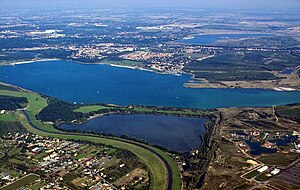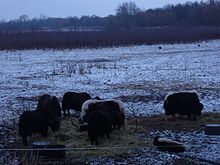Elster reservoir Bösdorf
| Elster reservoir | |||||||||
|---|---|---|---|---|---|---|---|---|---|
| Elsterstausee (front) in front of Cospudener and Markkleeberger See (2005) | |||||||||
|
|||||||||
|
|
|||||||||
| Coordinates | 51 ° 15 ′ 40 ″ N , 12 ° 19 ′ 0 ″ E | ||||||||
| Data on the structure | |||||||||
| Construction time: | 1933-1935 | ||||||||
| Height above valley floor: | 5 m | ||||||||
| Height of the structure crown: | 118.7 m | ||||||||
| Crown length: | 2 800 m | ||||||||
| Crown width: | 5 m | ||||||||
| Data on the reservoir | |||||||||
| Water surface | 50 ha (until 1976 100 ha) | ||||||||
| Storage space | 1 million m³ | ||||||||
The Elsterstausee Bösdorf (also Bösdorf reservoir , regionally mostly just Elsterstausee ) is located on the southern city limits of Leipzig in Saxony , west of the Cospudener See .
history
The reservoir was created in the years 1933 to 1935 east of the places Hartmannsdorf and Bösdorf ; at that time it was about 1,800 meters long and 800 meters wide. An earth dam serves as a barrier structure . It was fed by the Elstermühlgraben, which had existed since the Middle Ages and which led the main part of the Elsterwasser until the 1970s. Initially, the lake was also used for fish farming, from 1950 also for recreational purposes.
Construction began in July 1933. The city of Leipzig was the developer. Construction planning and site management were in the hands of the Saxon Hydraulic Engineering Directorate in Dresden, and construction was carried out by the State New Construction Office in Elsterordnung Leipzig. When it was completed in 1935, the reservoir was 1700 m long and up to 700 m wide with a total size of 100 ha. The water depth increased from 1.5 m to 3.5 m from south to north.
With the construction of the reservoir and its ancillary facilities, the following tasks should be solved:
- Regulation of the then "overgrown" Elster course and thus prevention of further large bank demolitions and reduction of bed load. The regulation extended to 2.8 km, the course of the river was shortened by about 1 km.
- Restraint of the bed load (gravel and sand) carried along by the Elster, especially during floods, and the settling suspended matter (sludge) in a sedimentation basin connected to the Elster above the reservoir. The basin was 4.5 hectares in size and cut 5.5 m deep into the terrain. The aim was to relieve the Elster flood basin from the sedimentation that had to be removed on an ongoing basis.
- Biological purification of the Elstermühlgraben water in the reservoir through natural effects.
The biological purification was particularly necessary because the domestic and commercial wastewater discharged into the Elster had led to such severe pollution that natural self-cleaning of the water was no longer possible. In the reservoir, the water absorbs oxygen on the surface, a world of small organisms develops in the water that degrades most of the dissolved and undissolved pollutants in the water. Fissure fungi, diatoms, flagellates, rotifers, water fleas, worms, snails and insect larvae are the beginning of a food chain that is used to feed the fish used. By 1936 around 100,000 carp, tench and eel were used.
The reservoir is not cut into the terrain like the sedimentation basin, but placed on top of the upcoming meadow area. The embankment embankments, with an average height of 2.5 m, were poured from the mass (approx. 500,000 cubic meters) obtained during the excavation of the sedimentation basin and the river regulation. The dams were sealed by means of a rolled-in clay apron, which is protected from the impact of waves by a 12 cm thick concrete slab. The entire bottom of the reservoir has been sealed. The former Elsterlauf was filled with clay and rolled in.
Between 1976 and 1982 the reservoir was reduced in size for the expansion of the Zwenkau open-cast lignite mine , and the southern half was separated by means of a dam. Since then, the water level has been higher than that of the passing White Elster , from which water was constantly pumped up. The dam was renovated in 1998.
present
Until 2009 the reservoir was used for recreation, including swimming, sailing and rowing boats. It was one of the few lakes in Germany that were suitable for ice sailing.
The bottom of the lake had been leaking since around 2005, so that the water level fell or could only be kept stable with great effort. In the summer of 2009 it was almost completely dry. In June 2009 the Leipzig city council decided to save the Elsterstausee if this was economically justifiable. He commissioned an expert opinion on this, which was completed in spring 2010. There different ways of saving the lake are described. In autumn 2010, the city of Leipzig signed a five-year lease. This is to prevent sheep grazing on the lake bed from being forested in the area.
With the resolution of the council meeting on April 12, 2017, the status of the Elster reservoir as a body of water / dam in accordance with Sections 67 and 68 of the Saxon Water Act was given up. In future, the lake bed should primarily serve to maintain the landscape and maintain the flood protection systems of the White Elster. The surroundings of the lake are to be developed as an extensive recreational area.
Individual evidence
- ^ Horst Riedel: Stadtlexikon Leipzig, Pro Leipzig, 2005, pp. 130f. Elstermühlgräben , Elsterstausee
- ↑ Bernd Reiher: Elsterstausee takes city council hurdles: Ingo Sasama in an interview . In: Leipziger Internet Zeitung , June 20, 2009
- ↑ Bernd Reiher: 15 times conservation, partial conservation or task: variant investigation of Elster reservoir. Leipzig internet newspaper, November 5, 2010
- ↑ Excerpt - Further development of the former Elster reservoir - decision of principle. In: City of Leipzig Ratsinformationssystem. City of Leipzig, accessed on June 21, 2017 .
literature
"The Elsterstausee and the Elster-Luppe-Regulation" by government architect Natzschka, Eichenblatt-Verlag (Max Zedler), Leipzig, 1936





